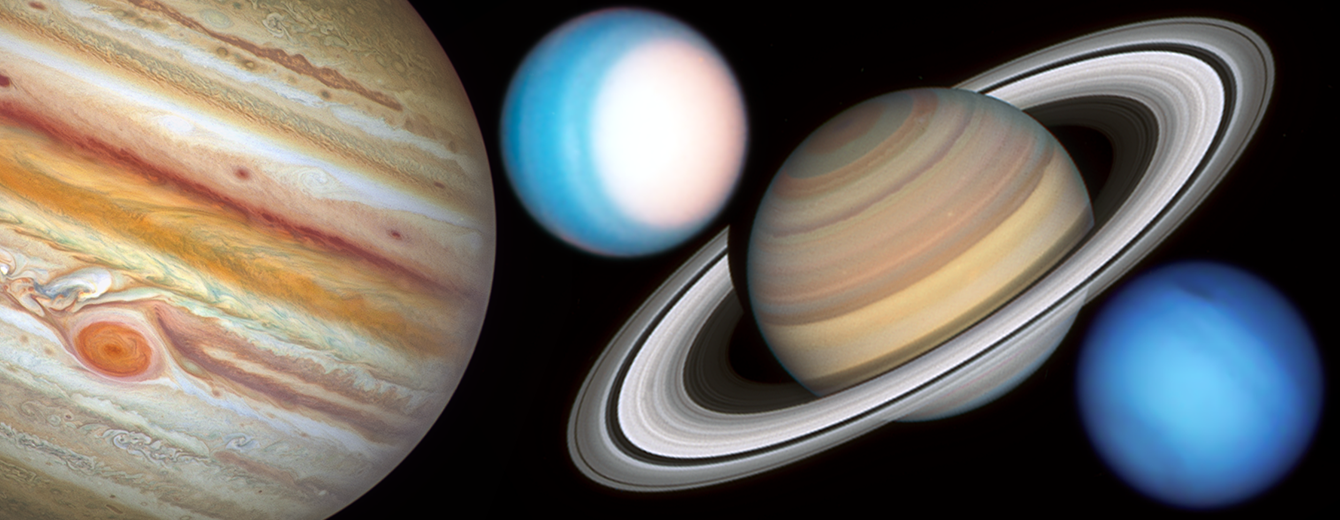Gravity acts as a lens, magnifying and distorting space and time in a way that is similar to an optical lens like those in eyeglasses or contact lenses. As light passes through a gravitational lens, it may take different paths, producing multiple images of the same object. When that light emerges from the lens, we see several contorted images of a single object. Gravitational lenses help boost our view, allowing Hubble to capture faint, distant objects.

 Einstein Cross G2237+0305NASA, ESA, and J. Lotz and the HFF Team (STScI)
Einstein Cross G2237+0305NASA, ESA, and J. Lotz and the HFF Team (STScI)Five months after its April 1990 launch, Hubble captured four gravitationally lensed images of quasar G2237+0305. Called an Einstein Cross, the image reveals a distant quasar gravitationally lensed four times by a relatively nearby galaxy (visible as bright smudge at the center of the cross).

 Supernova Refsdal and Galaxy Cluster MACS J1149.6+2223NASA, ESA, and S. Rodney (JHU) and the FrontierSN team; T. Treu (UCLA), P. Kelly (UC Berkeley), and the GLASS team; J. Lotz (STScI) and the Frontier Fields team; M. Postman (STScI) and the CLASH team; and Z. Levay (STScI)
Supernova Refsdal and Galaxy Cluster MACS J1149.6+2223NASA, ESA, and S. Rodney (JHU) and the FrontierSN team; T. Treu (UCLA), P. Kelly (UC Berkeley), and the GLASS team; J. Lotz (STScI) and the Frontier Fields team; M. Postman (STScI) and the CLASH team; and Z. Levay (STScI)The enormous galaxy cluster MACS J1149.6+2223, located more than 5 billion light-years away, creates a gravitational lens that facilitated two of Hubble’s most exciting discoveries using gravitational lenses. The first was Supernova Refsdal. Hubble captured the supernova because the gravitational lens created by a massive galaxy embedded in MACS J1149.6+2223 bent and magnified its light. Refsdal is some 4.3 billion light-years farther than MACS J1149.6+2223 or 9.3 billion light-years from Earth.
 Icarus (MACS J1149+2223 Lensed Star 1)NASA, ESA, and P. Kelly (University of Minnesota)
Icarus (MACS J1149+2223 Lensed Star 1)NASA, ESA, and P. Kelly (University of Minnesota)First discovered in 2014, astronomers calculated how Refsdal’s light might move through MACS J1149.6+2223’s enormous gravitational lens and predicted its reappearance. While looking for and finding the supernova’s reappearance in MACS J1149.6+2223, they also found an enormous, distant, blue star they nicknamed Icarus.
Icarus is so far away that its light took 9 billion years to reach Earth. Because the star’s light had such a long distance to travel, Hubble's observations captured the star as it appeared when the universe was about 30 percent of its current age.
 EarendelNASA, ESA, Brian Welch (JHU), Dan Coe (STScI); Image Processing: Alyssa Pagan (STScI)
EarendelNASA, ESA, Brian Welch (JHU), Dan Coe (STScI); Image Processing: Alyssa Pagan (STScI)Just four years after the discovery of Icarus, Hubble broke its own record by finding a more distant star, called Earendel, in a gravitational lens created by a huge galaxy cluster called WHL0137-08. The star sits in a ripple of spacetime (indicated by the dotted line) that produces extreme magnification, allowing Earendel to stand out against its host galaxy, which appears as a red arc. It took Earendel’s light 12.9 billion years to reach Earth, traveling at 186,000 miles per second (300,000 km per second). Hubble’s image captured the star as it appeared when the universe was only seven percent of its current age – within the first billion years after the universe’s birth in the big bang – making it the most distant individual star ever seen.
Learn More
Hubble Science Highlights
Discover the breadth and depth of Hubble's exciting discoveries!

Studying the Planets and Moons
Hubble’s systematic observations chart the ever-changing environments of our solar system's planets and their moons.

Tracking Evolution in the Asteroid Belt
These conglomerates of rock and ice may hold clues to the early solar system.

Uncovering Icy Objects in the Kuiper Belt
Hubble’s discoveries helped NASA plan the New Horizon spacecraft’s flyby of Pluto and beyond.

Exploring the Birth of Stars
Seeing ultraviolet, visible, and near-infrared light helps Hubble uncover the mysteries of star formation.

The Death Throes of Stars
When stars die, they throw off their outer layers, creating the clouds that birth new stars.

Finding Planetary Construction Zones
Hubble’s sensitivity uncovers the seeds of planets in enormous disks of gas and dust around stars.

Recognizing Worlds Beyond Our Sun
Hubble can detect and measure the basic organic components for life on planets orbiting other stars

Seeing Light Echoes
Like ripples on a pond, pulses of light reverberate through cosmic clouds forming echoes of light.

Tracing the Growth of Galaxies
Hubble's Deep Field observations are instrumental in tracing the growth of galaxies.

Galaxy Details and Mergers
Galaxies evolve through gravitational interaction with their neighbors, creating a menagerie of forms.

Monster Black Holes are Everywhere
Supermassive black holes lie at the heart of nearly every galaxy.

Homing in on Cosmic Explosions
Hubble helps astronomers better understand and define some of the largest explosions in the universe.

Discovering the Runaway Universe
Our cosmos is growing, and that expansion rate is accelerating.

Shining a Light on Dark Matter
The gravitational pull of dark matter guides the formation of everything we can see in the universe.

Mapping the Cosmic Web
Filaments and sheets of matter create an interconnected web that forms the large-scale structure of the universe.








